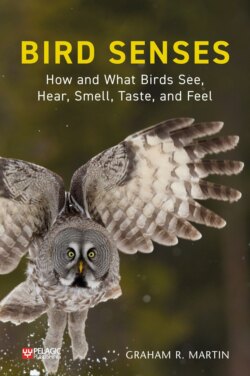Читать книгу Bird Senses - Graham R. Martin - Страница 33
На сайте Литреса книга снята с продажи.
Elaborating the task
ОглавлениеDetermining an average acuity threshold is likely to be just the beginning of a much longer series of investigations. With well-trained and motivated birds, and highly motivated investigators, it is possible to repeat the investigations at different light levels or repeat them changing the contrast between the stripes. It is usual to start the investigation at high light levels, equivalent to daytime, and use grating patterns that contrast very highly. But many of the more interesting questions about what information is available to birds in their natural environments occur when light levels are not those of midday and when patterns are not highly contrasting. Most real-world tasks involve detecting objects that differ by shades of grey.
By systematically altering both light levels and contrast it is possible to investigate how a bird’s acuity will differ between daylight, twilight and night-time, and how its ability to see details changes as contrast reduces. Actually, getting birds to continue working at very low light levels and at low contrasts takes a lot of ingenuity. This is because when tasks start to get difficult the bird may simply stop responding and hunker down until the task gets easier. Therefore, getting runs of thresholds for a wide range of light levels and contrasts can be very difficult. As a consequence, most studies tend to report acuity at a single light level and contrast, or within a narrow range. One further problem of working at low light levels is that the birds must be allowed to ‘dark adapt’ to the required low light after being placed into the apparatus, and the light levels need to stay the same throughout a session. This can add greatly to the time a session takes and decrease the motivation of the bird to respond.
